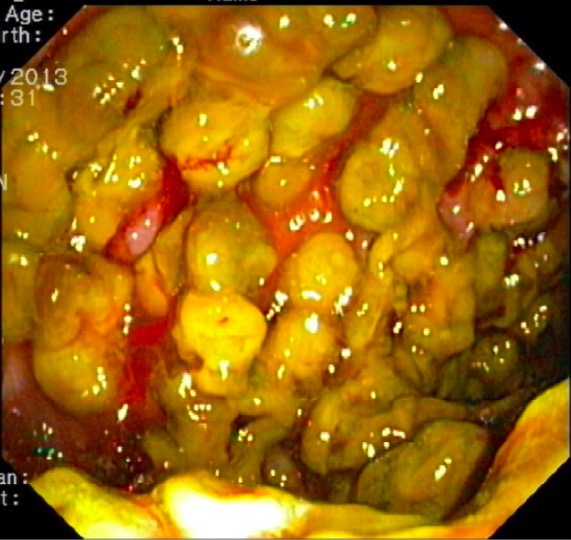Playlist
Show Playlist
Hide Playlist
Clostridioides Difficile Infection with Case
-
Slides Gastroenterology 08 Disorders Large Intestine I.pdf
-
Reference List Gastroenterology.pdf
-
Download Lecture Overview
00:01 We'll move on to our next case. 00:03 A 57-year-old man is admitted to the hospital with community acquired pneumonia. 00:09 He is treated with ceftriaxone and azithromycin. 00:12 On hospital day 4, he develops acute diarrhea with the passage of 5 to 7 liquid bowel movements a day. 00:19 His vitals show a fever to 38, heart rate of 95, blood pressure 125/88 and his oxygen saturation is 97% on room air. 00:30 His heart and lung exam is normal. 00:32 He has hyperactive bowel sounds with mild tenderness to palpation throughout his abdomen without rebound or guarding. 00:39 His labs are notable for a leukocyte count of 15,000. 00:44 So what is the best next step in diagnosis? So we'll point out here that he has acute watery diarrhea in the setting of a recent hospitalization with recent antibiotic exposure. 00:58 His vitals are notable for fever and tachycardia. 01:02 He has localizing signs on exam of potential colitis. 01:07 And he has an elevated white cell count which is concerning for severe infection. 01:12 Let´s first talk about Clostridioides difficile, previously known as Clostridium difficile. 01:20 It is the most common cause of health care associated colitis and we're seeing an increasing incidence in the community as well. 01:29 The biggest risk factor for a C.diff infection is just recent antibiotic exposure as any antibiotics that patients take may wipe out their normal colonic flora and allow space and room for the C.difficile to then grow. 01:45 Patients may come with diarrhea, typically more than 3 watery bowel movements in 24 hours. 01:50 They may have fever, abdominal pain. 01:53 As with our patient, they may have leukocytosis and sepsis. 01:58 The diagnosis now is made with stool PCR or an enzyme immunoassay for the C.difficile toxin. 02:05 Over here on the right, you see a colonoscopy showing the typical appearance of C.difficile with thick pseudomembranes which are those large white plaques throughout the colon. 02:16 This is typical of a C.diff infection. 02:19 However, nowadays, since we have convenient PCR and enzyme immunoassay testing, we don't need to do colonoscopy for the diagnosis. 02:29 The treatments depends on the severity and number of episodes. 02:33 So we'll go into that next. 02:36 Before we talk about treatment, let's just quickly review other causes of acute diarrhea. 02:42 I'll refer you back to the approach to the patient with diarrhea, for all the other causes of diarrhea that could be in your differential. 02:52 So, we mention that treatment of C.difficile infection depends on the severity. 02:58 So what things make it a severe infection? Some of the variables include a white count greater than 15,000, a creatinine greater than 1.5, the presence of hypotension or shock or the presence of an ileus or megacolon which is when the colon becomes very dilated from this infection. 03:18 So the treatments depends on the severity of the infection. 03:21 The first step on your treatment algorithm is to assess for a fulminant or the most severe type of C.diff infection. 03:29 This is by asking whether the patient has ileus, shock or megacolon. 03:34 If they do have any of those findings, you should treat them for fulminant C.diff. 03:38 which involves giving oral or rectal vancomycin and IV metronidazole. 03:44 You should also do an early surgical consultation as they may frequently develop surgical complications. 03:50 If your patient does not have any of those features, you then assess their severity based on these two parameter: So their white count and their creatinine. 04:00 If they meet those parameters, then this is considered a severe C.diff infection. 04:05 You should treat those patients with oral vancomycin or oral fidaxomicin and consider adding IV metronidazole if their clinical picture continues to worsen. 04:17 If it is not a severe infection, then we just treat with oral vancomycin or oral fidaxomicin. 04:24 So now let's return to our case. 04:26 We have a 57-year-old man who was admitted with pneumonia, now having acute watery diarrhea in the setting of recent antibiotics. 04:35 He has signs of sepsis on his physical exam and his white count is quite high concerning for a severe infection. 04:43 So the best next step in diagnosis is to suspect C. difficile infection and check a stool PCR or EIA for this toxin. 04:53 Thank you very much for your attention.
About the Lecture
The lecture Clostridioides Difficile Infection with Case by Kelley Chuang, MD is from the course Disorders of the Small and Large Intestines.
Included Quiz Questions
Which of the following is the best treatment option for fulminant Clostridium difficile infection?
- Oral vancomycin and IV metronidazole
- Oral vancomycin
- Oral fidaxomicin
- Oral ceftriaxone
- IV ceftriaxone
Which of the following is used for the diagnosis of Clostridium difficile infection?
- Enzyme immunoassay for Clostridium difficile toxin
- Endoscopy
- Abdominal X-ray
- Abdominal CT
- Flexible sigmoidoscopy
Customer reviews
5,0 of 5 stars
| 5 Stars |
|
5 |
| 4 Stars |
|
0 |
| 3 Stars |
|
0 |
| 2 Stars |
|
0 |
| 1 Star |
|
0 |




